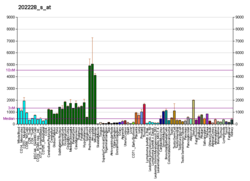
Protein NDRG4 is a protein that in humans is encoded by the NDRG4 gene.

Chromatin modification-related protein MEAF6 is a protein that in humans is encoded by the MEAF6 gene.

ATP-binding cassette super-family B member 6, mitochondrial is a protein that in humans is encoded by the ABCB6 gene.

Cold shock domain-containing protein C2 is a protein that in humans is encoded by the CSDC2 gene.

Lysine-specific demethylase 4B is an enzyme that in humans is encoded by the KDM4B gene. KDM4B belongs to the alpha-ketoglutarate-dependent hydroxylase superfamily.

Proteasome-associated protein ECM29 homolog is a protein that in humans is encoded by the KIAA0368 gene.

Thioredoxin domain-containing protein 12 is a protein that in humans is encoded by the TXNDC12 gene.

Vacuolar protein sorting-associated protein VTA1 homolog is a protein that in humans is encoded by the VTA1 gene.

Transmembrane and coiled-coil domain-containing protein 1 is a protein that in humans is encoded by the TMCO1 gene.

Choline transporter-like protein 2 is a protein that in humans is encoded by the SLC44A2 gene.

Olfactomedin 1, also known as noelin 1 or pancortin, is a protein that in humans is encoded by the OLFM1 gene. The name noelin stands for "neuronal olfactomedin-related endoplasmic reticulum-localized 1".

TBC1 domain family member 9 is a protein that in humans is encoded by the TBC1D9 gene.

Low-density lipoprotein receptor-related protein 10 is a protein that in humans is encoded by the LRP10 gene.

ER degradation-enhancing alpha-mannosidase-like 2 is an enzyme that in humans is encoded by the EDEM2 gene.

U3 small nucleolar ribonucleoprotein protein IMP4 is a protein that in humans is encoded by the IMP4 gene.

Chemokine-like protein TAFA-5 is a protein that in humans is encoded by the TAFA5 gene.

SAC3 domain-containing protein 1 is a protein that in humans is encoded by the SAC3D1 gene.

Palmitoyltransferase ZDHHC3 is an enzyme that in humans is encoded by the ZDHHC3 gene that contains a DHHC domain.

Caspase activity and apoptosis inhibitor 1 is a protein that in humans is encoded by the CAAP1 gene.

Synaptic vesicle glycoprotein 2B is a protein that in humans is encoded by the SV2B gene.

















